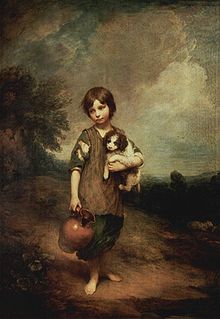Fancy pictures are a sub-genre of genre paintings in 18th-century English art, featuring scenes of everyday life but with an imaginative or storytelling element, usually sentimental. The usage of the term varied, and there was often an overlap with the conversation piece, a type of group portrait showing the subjects engaged in some activity.

Most fancy pictures depict children or young women, life-size or somewhat smaller, but some are landscapes with figures.[1] The people depicted are more "democratic" than the upper-class subjects of portraits,[2] and are characteristically portrayed with what has been termed "a sort of contrived innocence",[1] sometimes eroticised.[1][2]
The term derives from fancies, which the art critic and historian George Vertue used in 1737 to describe paintings by Philip Mercier such as Venetian Girl at a Window or the series The Five Senses, which incorporate a storyline or invented or imagined elements.[3][4] Joshua Reynolds coined the extended term 'fancy pictures' in 1788 for the works painted by Thomas Gainsborough in his final decade, particularly those depicting beggar and peasant children.[3] Following his death, Gainsborough was initially best known for these pictures.[5] Reynolds' own fancy pictures, while using street children as models, have allegorical and classical titles such as Hope Nursing Love and Venus Chiding Cupid.[6] The sub-genre owes inspiration to Rembrandt and Murillo and was influenced by 18th-century French works, particularly by Chardin, Greuze,[1] as Mercier had been influenced by European artists including Watteau, but it is not a distinct sub-genre in French painting.[7]
Eighteenth-century fancy pictures were an antecedent of Victorian sentimentalism; J. E. Millais' paintings of children, such as his My First Sermon and My Second Sermon, modelled by his young daughter, were called fancy pictures.[8]
References
edit- ^ a b c d David Mannings, "Fancy picture", Grove Art Online, doi:10.1093/gao/9781884446054.article.T027491, retrieved 19 February 2020 (subscription required for full access).
- ^ a b Susan B. Egenolf, The Art of Political Fiction in Hamilton, Edgeworth, and Owenson, Farnham / Burlington, Vermont: Ashgate, 2009, ISBN 9780754662037, p. 82.
- ^ a b "Fancy picture", Tate Britain, retrieved 19 February 2020.
- ^ John Chu, "'Newly Invented Original Paintings': Philip Mercier and the Origins of the British Fancy Picture", lecture, Paul Mellon Centre for Studies in British Art, 13 June 2017.
- ^ Ellis K. Waterhouse, "Gainsborough's 'Fancy Pictures'", The Burlington Magazine, 88.519 (June 1946) 134–41.
- ^ "Fancy picture", Oxford Ready Reference, from The Oxford Dictionary of Art and Artists, retrieved 19 February 2020.
- ^ Melissa Percival, Fragonard and the Fantasy Figure: Painting the Imagination, [2012], London / New York: Routledge, 2017, ISBN 9781315094007, p. 71.
- ^ Kumiko Tanabe, "Hopkins's Obsession with Beauty and Fancy: The Influence of the Parnassian Movement and the Fancy Picture of J. E. Millais", in The Interconnections between Victorian Writers, Artists and Places, ed. Kumiko Tanabe, Newcastle upon Tyne: Cambridge Scholars, 2019, ISBN 9781527539983, pp. 48–66, p. 55.
Further reading
edit- Martin Postle, Angels & Urchins: The Fancy Picture in 18th-Century British Art, Exhibition catalogue, Nottingham: Djanogly Art Gallery / Lund Humphries, 1998, ISBN 9781900809450.